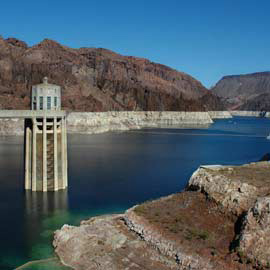Lake Mead could be dry by 2021
Lake Mead could dry up by 2021
Scripps Institution of Oceanography
February 12, 2008
|
|
There is a 50 percent chance Lake Mead, a key source of water for millions of people in the southwestern U.S., will be dry by 2021 if climate changes as expected and future water usage is not curtailed, a new study finds.
Without Lake Mead and neighboring Lake Powell, the Colorado River system has no buffer to sustain the population of the Southwest through an unusually dry year, or worse, a sustained drought, the study authors say. In such an event, water deliveries would become highly unstable and variable.
The research team concludes that human demand, natural forces such as evaporation, and human-induced climate change are creating a net deficit of nearly 1 million acre-feet of water per year from the Colorado River system that includes Lake Mead and Lake Powell. This amount of water can supply roughly 8 million people. The team’s analysis of Federal Bureau of Reclamation records of past water demand and calculations of scheduled water allocations and climate conditions indicate that the system could run dry even if mitigation measures now being proposed are implemented.
 Lake Mead at Hoover Dam, October, 2007. According to Scripps researchers, Lake Mead could be dry by 2021 if climate changes as expected and future water usage is not curtailed. Photo courtesy of Dr. Ken Dewey, Applied Climate Sciences Group, University of Nebraska, Lincoln. Climate change could turn Southwest into “Dustbowl” April 5, 2007 |
A paper detailing these findings has been accepted for publication in Water Resources Research, a journal of the American Geophysical Union, and is accessible via the AGU’s web site (see instructions below).
“We were stunned at the magnitude of the problem and how fast it was coming at us,” says marine research physicist and study coauthor Tim Barnett of the Scripps Institution of Oceanography of the University of California at San Diego. “Make no mistake, this water problem is not a scientific abstraction, but rather one that will impact each and every one of us that live in the Southwest.”
“It’s likely to mean real changes to how we live and do business in this region,” adds coauthor David Pierce, a climate scientist at Scripps, which is located in La Jolla, California.
The Lake Mead/Lake Powell system includes the stretch of the Colorado River in northern Arizona. Lake Mead straddles the Arizona-Nevada border and Lake Powell is on the Arizona-Utah border. Aqueducts carry water from the system to Las Vegas, Los Angeles, San Diego, and other communities in the Southwest. Currently the system is only at half capacity because of a recent string of dry years, and the team estimates that the system has already entered an era of deficit.
“When expected changes due to global warming are included as well, currently scheduled depletions are simply not sustainable,” Barnett and Pierce write in the paper.
The researchers note that a number of other studies in recent years have estimated that climate change will lead to reductions in runoff to the Colorado River system. Those analyses consistently forecast reductions of between 10 and 30 percent over the next 30 to 50 years, which could affect the water supply of between 12 and 36 million people.
Barnett and Pierce estimate that there is a 10 percent chance that Lake Mead could be dry by 2014. They further predict that there is a 50 percent chance that reservoir levels will drop too low to allow hydroelectric power generation by 2017.
The researchers add that even if water agencies follow their current drought contingency plans, those measures might not be enough to counter natural forces, especially if the region enters a period of sustained drought or if human-induced climate changes occur as currently predicted.
Barnett says that the researchers chose to go with conservative estimates of the situation in their analysis, though the water shortage is likely to be more dire in reality. The team bases its findings on the premise that climate change effects only started in 2007, though most researchers consider human-caused changes in climate to have likely started decades earlier. Barnett and Pierce also base their river flow on averages over the past 100 years, even though it has dropped in recent decades. Over the past 500 years the average annual flow is even less.
“Today, we are at or beyond the sustainable limit of the Colorado system. The alternative to reasoned solutions to this coming water crisis is a major societal and economic disruption in the desert southwest; something that will affect each of us living in the region,” the report concludes.
Barnett, T. P., and D. W. Pierce (2008), When Will Lake Mead go Dry?, Water Resour. Res., doi:10.1029/2007WR006704, in press.